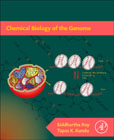
Chemical Biology of the Genome is the first book to provide a comprehensive overview of essential concepts and principles of genomic and epigenomics dynamics, as explored through the lens of chemical biology. Key examples and case studies illustrate chemical biology methods for study and analysis of the genome and epigenome, with emphasis on relevance to physiological and pathophysiological processes and drug discovery. Authors and international leaders in biochemical studies of the genome, Drs. Siddhartha Roy and Tapas Kundu, adopt an integrated, interdisciplinary approach throughout, demonstrating how fast evolving chemical and mass-scale sequencing tools are increasingly being used to interpret biochemical processes of the genome and explore potential applications in healthcare and pharmaceuticals. Later sections discuss chemical modifications of the genome, DNA sequence recognition by proteins and gene regulation, GWAS and EpiGWAS studies, 3D architecture of the genome, and functional genome architecture. In-depth discovery focused chapters examine intervention in gene networks using SiRNA/ShRNA, miRNA, and anti-miR; small molecule modulation of iPS; drug resistance pathways; altered DNA methylation as drug targets; anti-miR as therapeutics; and nanodelivery of drugs. Offers an interdisciplinary discussion of the chemical biology of the genome and epigenome, employing illustrative case studies in both physiological and pathophysiological contextsSupports researchers in employing chemical and mass-scale sequencing approaches to interpret genomic and epigenomic dynamicsHighlights innovative pathways and molecular targets for new disease study and drug discovery INDICE: I. An integrative approach to chemical biology. a) Philosophy behind the integrative approach b) Ensembles of molecules possess fundamentally different properties than individual molecules c) Physical tools for studying ensembles and their properties d) Chemical Genetics: A powerful approach to study cellular functions e) Genes and Genomes: An integral entity II. Genes, Genomes and Genome Dynamics. a) Genes: The building block Definition, identification, functional genes: an evolution in thoughts and ideas b) Genome: Complexity and Diversity. the organization of genes, the organization of genomes, the structure of chromatin c) Unstable genes: Biology and Chemistry. unstable loci, why some genes are unstable (chemical and physical perspectives). Biological trigger for jumping genes d) The Dynamic Epigenome: Epigenetic Modifications and reversible changes. Reversible histone modifications, DNA methylation, Hydroxymethylation, Noncoding RNA and genome stability III. Chemical modifications of the genome a) Electrophilic and Nucleophilic substitution reactions b) DNA structure c) Chemical modifications of DNA d) Chemical modifications of proteins e) Enzymes involved in chemical modifications of proteins and DNA f) Modification of histones and their role in gene regulation IV. DNA sequence recognition by proteins and gene regulation. a) DNA recognition motifs of DNA-binding proteins b) Sequence recognition versus shape recognition c) Thermodynamics of sequence-specific recognition d) Origin of sequence specificity, in prokaryotes and eukaryotes e) Regulation of gene expression in prokaryotes: Chemical Principals f) Regulation of gene expression in eukaryotes: Chemical Principles g) Designed Transcription factors h) Gene regulatory networks V. Elucidation of genome sequence and functional architecture by chemical biology approach. a) Genome Sequencing: rapid evolution in the technology b) Genome-wide Cooperation: GWAS and EpiGWAS: c) GWAS: Regulatory elements, Transcription and replication perspective, enhancer, super-enhancer, RNA pol II binding sites d) EpiGWAS: methylome, histone modifications, book marking e) 3D architecture of the Genome: chromatin territories, CT and ICT relations (dynamics), small molecule metabolites interactions, functional foci, movements of territories. f) Capturing the genome dynamics: capturing dynamic genome (3C to 5C) implications in disease diagnosis, and prediction VI. Chemical genomics: Understanding differentiation and disease (Using siRNA and small molecule) a) Intervention in gene networks using SiRNA/ShRNA, miRNA and anti-miR b) Small molecule modulation of iPS c) Elucidation of Neural and Muscle differentiation pathways by means of chemical biology approach d) Elucidation of Disease Biology e) Drug resistance pathways VII. Chemical Biology: Drug discovery targeting the functional genome. a) Using networks perspectives to discover drug targets b) Altered DNA methylation as drug targets: DNMT inhibitor, DNMT inhibitor and metastasis, correlations with histone modifications c) Combinatorial therapeutic molecules targeting in the reverse direction d) Targeting specific gene expression to counter Drug resistance: e) Anti-miR as therapeutics f) Nanodelivery of drugs: a targeted Phenomenon. Classes of drug delivery vehicle, g) Applications: receptor ligand modification and nano-vehicle, organ specific delivery, indirect targeting, tissue toxicity
- ISBN: 978-0-12-817644-3
- Editorial: Academic Press
- Encuadernacion: Rústica
- Páginas: 384
- Fecha Publicación: 01/06/2020
- Nº Volúmenes: 1
- Idioma: Inglés
